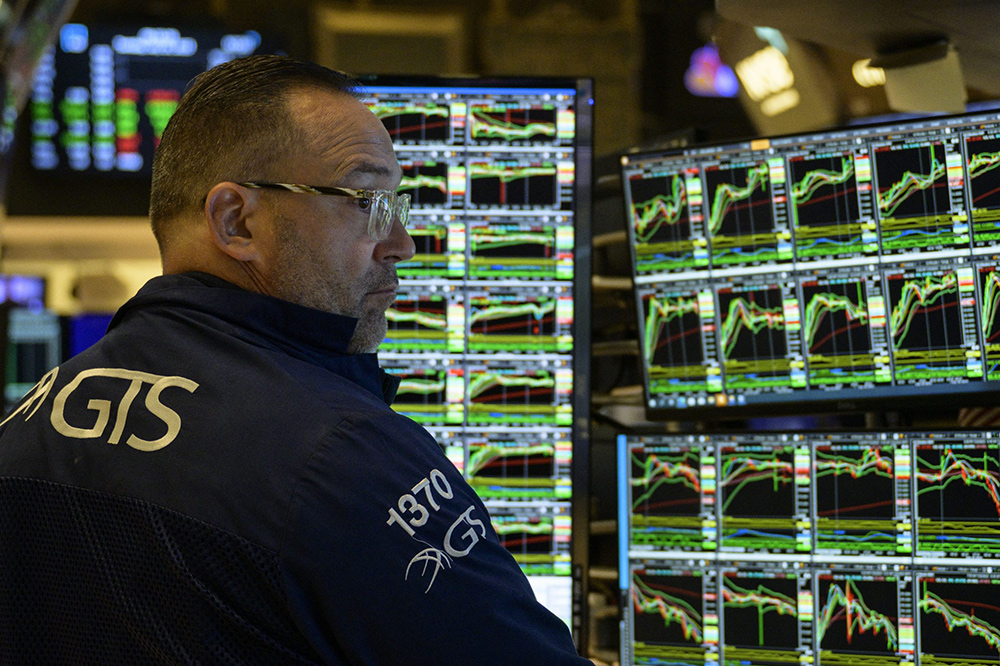
去年12月,贝莱德(BlackRock)的首席分析师们向客户“预言”美国将陷入经济衰退。他们警告,美联储为了控制通胀激进加息,最终会导致大量失业和GDP增速下滑。但目前随着通胀回落,GDP持续增长,劳动力市场继续展现出韧性,全球最大资产管理公司的专家们至少对于短期的未来形势,变得更加乐观。
贝莱德智库(BlackRock Investment Institute)主席珍·伯伊文和副主席艾利克斯·布拉齐尔在8月14日的一篇博客中写道:“我们的基础情景是,随着高利率的影响完全显现,消费者用光疫情期间的储蓄,美国经济将在未来一年继续停滞不前。”
虽然经济停滞略好过经济萎缩,但伯伊文和布拉齐尔指出,如果他们的预测正确,美国经济将在未来两年半基本“停滞不前”。他们解释称:“这将是二战结束以来,除了全球金融危机以外,经济最疲软的一段时期。”他们所说的是2008年次贷危机导致的金融危机。
伯伊文和布拉齐尔还认为,美国经济正在经历“大规模结构性转型”,从长远来看会给美国带来麻烦。人口结构的变化和提前退休人数的增加,导致美国退休人数的占比大幅增加。这可能导致劳动力短缺,进而会使经济增速放缓,可能再次引发通货膨胀。
他们在周一写道:“我们评估的结果是,美国经济可能进入‘充分就业型停滞’。”他们认为,随着劳动力短缺的影响在2024年开始“显现”,通货膨胀将“如过山车一般起伏”并重新爆发。
形势并未好转
贝莱德表示,过去几年,消费者消费模式的变化和疫情以及与战争有关的供应链问题,导致经济“错配”,使通胀加剧。
实际上,美国经济无法生产人们希望购买的商品,而这种供需失衡导致物价暴涨。但现在,虽然供需失衡问题正在“得到解决”,使通胀回落,但劳动力短缺可能导致消费物价再次上涨,并且涨幅会更加猛烈。
伯伊文和布拉齐尔发现,美国的劳动力与按照疫情之前的增长速度本应达到的水平相比,存在400万人的缺口。他们认为,由于人口结构变化,目前美国劳动力每年平均增幅只有0.5%,而疫情之前高达1.5%。
这可能导致“充分就业型停滞”,即劳动力短缺刺激通胀,进而导致经济增长疲软。伯伊文和布拉齐尔解释称:“这应该会导致经济收入的分配方式发生变化:更多收入被分配给员工和较少部分公司及其股东。”
贝莱德表示,工资上涨对于上班族而言是好消息,但与此同时,公司的利润减少、成本上涨,并且“可能会抑制商业投资”和引爆通胀。除此之外,伯伊文和布拉齐尔警告称:“劳动力减少意味着美国经济在不再次引发通货膨胀的情况下可以维持的增长率降低:更接近1%,而不是我们习以为常的2%。”
当然,一些经济学家甚至亿万富翁CEO们都认为,工资上涨并不会给美国经济带来麻烦。喜达屋资本(Starwood Capital)创始人兼CEO巴里·斯特恩利希特去年九月对《财富》杂志表示,即使工资上涨导致通胀率升高,这可能并非最糟糕的权衡。
他说道:“我认为整个对话的主题都是错误的。我并不认为我们需要恢复到2%的通胀率。我的意思是说,工资上涨所引发的通货膨胀是好事。我们应该希望工资上涨,因为这将帮助解决美国的社会问题。这是在低失业率的情况下,我们一直以来所期待的涓滴效应。”
来自美联储的警告
美联储认为充分就业型停滞是一个严峻的问题。在劳动力短缺导致工资上涨的情况下持续控制通货膨胀,同时保证经济继续增长,这将是一项真正的挑战。
除此之外,事实证明,过去刺激经济增长的策略,包括降息或购买政府债券和抵押贷款担保证券,面对未来劳动力短缺的情况下更有可能刺激通胀,因为低利率和流动性增加会引发不可持续的工资上涨。
因此,伯伊文和布拉齐尔给美联储官员传达了一条信息:
“这并不是商业周期。我们目前正在经历结构性转型。货币政策无法避免经济疲软。美联储需要保证美国经济的增长速度,不会超过目前不引发通货膨胀的情况下可维持的水平。”(财富中文网)
翻译:刘进龙
审校:汪皓
2023年7月25日,纽约证券交易所。摄影师:ANGELA WEISS/法新社经盖蒂图片社提供
去年12月,贝莱德(BlackRock)的首席分析师们向客户“预言”美国将陷入经济衰退。他们警告,美联储为了控制通胀激进加息,最终会导致大量失业和GDP增速下滑。但目前随着通胀回落,GDP持续增长,劳动力市场继续展现出韧性,全球最大资产管理公司的专家们至少对于短期的未来形势,变得更加乐观。
贝莱德智库(BlackRock Investment Institute)主席珍·伯伊文和副主席艾利克斯·布拉齐尔在8月14日的一篇博客中写道:“我们的基础情景是,随着高利率的影响完全显现,消费者用光疫情期间的储蓄,美国经济将在未来一年继续停滞不前。”
虽然经济停滞略好过经济萎缩,但伯伊文和布拉齐尔指出,如果他们的预测正确,美国经济将在未来两年半基本“停滞不前”。他们解释称:“这将是二战结束以来,除了全球金融危机以外,经济最疲软的一段时期。”他们所说的是2008年次贷危机导致的金融危机。
伯伊文和布拉齐尔还认为,美国经济正在经历“大规模结构性转型”,从长远来看会给美国带来麻烦。人口结构的变化和提前退休人数的增加,导致美国退休人数的占比大幅增加。这可能导致劳动力短缺,进而会使经济增速放缓,可能再次引发通货膨胀。
他们在周一写道:“我们评估的结果是,美国经济可能进入‘充分就业型停滞’。”他们认为,随着劳动力短缺的影响在2024年开始“显现”,通货膨胀将“如过山车一般起伏”并重新爆发。
形势并未好转
贝莱德表示,过去几年,消费者消费模式的变化和疫情以及与战争有关的供应链问题,导致经济“错配”,使通胀加剧。
实际上,美国经济无法生产人们希望购买的商品,而这种供需失衡导致物价暴涨。但现在,虽然供需失衡问题正在“得到解决”,使通胀回落,但劳动力短缺可能导致消费物价再次上涨,并且涨幅会更加猛烈。
伯伊文和布拉齐尔发现,美国的劳动力与按照疫情之前的增长速度本应达到的水平相比,存在400万人的缺口。他们认为,由于人口结构变化,目前美国劳动力每年平均增幅只有0.5%,而疫情之前高达1.5%。
这可能导致“充分就业型停滞”,即劳动力短缺刺激通胀,进而导致经济增长疲软。伯伊文和布拉齐尔解释称:“这应该会导致经济收入的分配方式发生变化:更多收入被分配给员工和较少部分公司及其股东。”
贝莱德表示,工资上涨对于上班族而言是好消息,但与此同时,公司的利润减少、成本上涨,并且“可能会抑制商业投资”和引爆通胀。除此之外,伯伊文和布拉齐尔警告称:“劳动力减少意味着美国经济在不再次引发通货膨胀的情况下可以维持的增长率降低:更接近1%,而不是我们习以为常的2%。”
当然,一些经济学家甚至亿万富翁CEO们都认为,工资上涨并不会给美国经济带来麻烦。喜达屋资本(Starwood Capital)创始人兼CEO巴里·斯特恩利希特去年九月对《财富》杂志表示,即使工资上涨导致通胀率升高,这可能并非最糟糕的权衡。
他说道:“我认为整个对话的主题都是错误的。我并不认为我们需要恢复到2%的通胀率。我的意思是说,工资上涨所引发的通货膨胀是好事。我们应该希望工资上涨,因为这将帮助解决美国的社会问题。这是在低失业率的情况下,我们一直以来所期待的涓滴效应。”
来自美联储的警告
美联储认为充分就业型停滞是一个严峻的问题。在劳动力短缺导致工资上涨的情况下持续控制通货膨胀,同时保证经济继续增长,这将是一项真正的挑战。
除此之外,事实证明,过去刺激经济增长的策略,包括降息或购买政府债券和抵押贷款担保证券,面对未来劳动力短缺的情况下更有可能刺激通胀,因为低利率和流动性增加会引发不可持续的工资上涨。
因此,伯伊文和布拉齐尔给美联储官员传达了一条信息:
“这并不是商业周期。我们目前正在经历结构性转型。货币政策无法避免经济疲软。美联储需要保证美国经济的增长速度,不会超过目前不引发通货膨胀的情况下可维持的水平。”(财富中文网)
翻译:刘进龙
审校:汪皓
In December, BlackRock’s top minds told their clients that a U.S. recession was “foretold.” The Federal Reserve’s aggressive interest rate hikes, although meant to merely tame inflation, would ultimately lead to a wave of job losses and falling GDP, they warned. But now with inflation fading, GDP growth continuing, and the labor market remaining resilient, experts at the world’s largest asset manager have become a bit more optimistic about the future—at least in the near term.
“Our base case is that the economy broadly flatlines for another year as the full impact of high interest rates comes through and consumers exhaust their pandemic savings,” Jean Boivin, head of the BlackRock Investment Institute, and his deputy head, Alex Brazier, wrote in an Aug. 14 blog post.
A stagnant economy is slightly better than a shrinking one, but Boivin and Brazier noted that if their prediction is correct, the economy will have essentially “flatlined” for two and a half straight years. “That would be the weakest such period in the postwar era outside the Global Financial Crisis,” they explained, referring to the financial meltdown caused by the subprime mortgage crisis in 2008.
Boivin and Brazier also argue that a “big structural shift” is underway that could cause problems for the U.S. in the long term. Changing demographics and a rise in early retirements are increasing the share of retirees in the U.S. population. That could lead to labor force shortages, which would slow the economy and have the potential to reignite inflation.
“Our assessment is that we are set for ‘full-employment stagnation,’” the pair wrote Monday, arguing that as labor shortages start to “bind” in 2024, inflation will go on a “roller-coaster ride” and reemerge.
Out of the fire and into the frying pan
Over the past few years, changing consumer spending patterns and pandemic and war-related supply-chain issues helped to create a “mismatch” in the economy that sparked the rise of inflation, according to BlackRock.
Essentially, the economy wasn’t set up to produce what people actually wanted to buy, and this supply-demand imbalance caused prices to surge. But now, although that imbalance is “resolving,” enabling inflation to fade, the labor shortage is threatening to bring consumer price increases back with a vengeance.
Boivin and Brazier found that the U.S. workforce is 4 million workers short of where it would have been if it kept growing at its pre-COVID pace. And due to demographics, the pair believe it will now grow by only 0.5% on average each year, compared to 1.5% before the pandemic.
That could cause “full-employment stagnation,” or a period of weak growth with rising inflation caused by labor shortages. “And that should lead to a shift in how all the income generated in the economy is being distributed: A greater share is ending up in employees’ pockets and a smaller share for companies and their shareholders,” Boivin and Brazier explained.
Rising wages are great for workers, but with increased pay comes less profit and increased costs for business, and that “could hold back business investment” and stoke inflation, according to BlackRock. And on top of that: “A smaller workforce means the rate of growth the economy will be able to sustain without resurgent inflation will be lower: more like 1% than the 2% we were used to,” Boivin and Brazier warned.
Of course, some economists—and even billionaire CEOs—believe that rising wages are not necessarily an issue for the economy. Barry Sternlicht, the founder and CEO of Starwood Capital, told Fortune last September that even if rising wages push inflation higher, that might not be the worst tradeoff.
“I think the whole dialogue is wrong. I don’t think we need 2% inflation,” he said. “I mean, inflation that is driven by wage growth is fabulous. We should want wages to go up—that will help social issues in the United States. It’s the trickle-down that we’ve all been waiting for with low unemployment.”
A word of warning for the Fed
For the Federal Reserve, full-employment stagnation is a serious concern. Keeping inflation sustainably at bay amid labor shortages that cause steadily rising wages, while also ensuring that the economy continues to grow, will be a real challenge.
On top of that, the tactics used to spark economic growth in the past, including cutting interest rates or buying government bonds and mortgage backed securities, may prove to be far more inflationary amid future labor force shortages as lower rates and increased liquidity could lead to unsustainable wage gains.
With that in mind, Boivin and Brazier had a message for central bank officials:
“This is not a business cycle. We are in the midst of a structural shift. Monetary policy cannot rescue the economy from weakness. The Fed will need to make sure the U.S. economy is not growing more quickly than what it can now maintain without inflation surging.”






